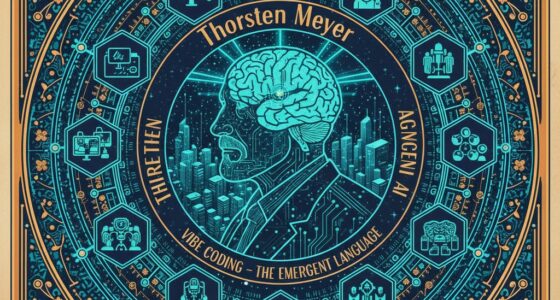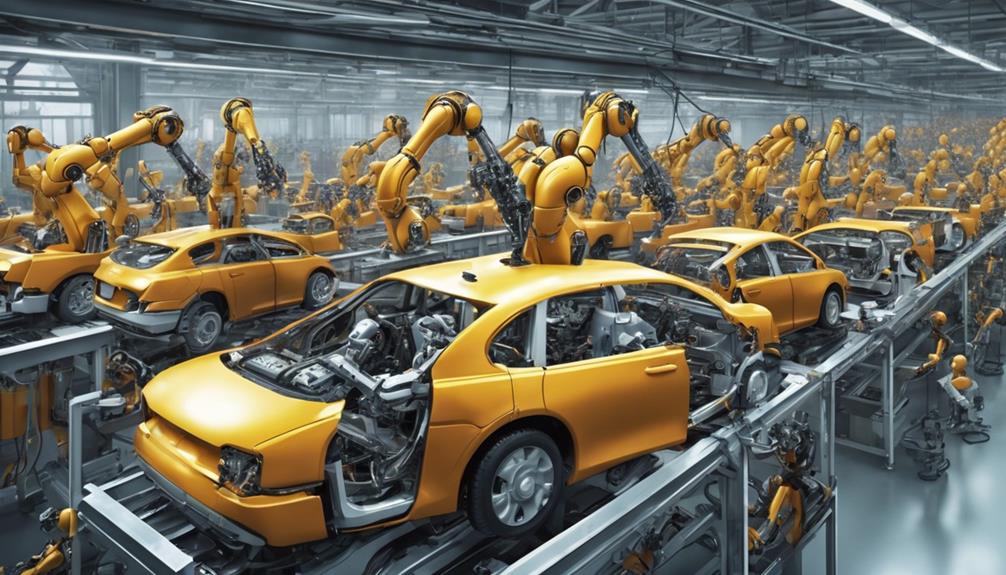Is our workforce prepared for the significant changes that the rise of artificial intelligence (AI) will bring? As a society, we are at a crucial crossroads, grappling with the potential effects of AI’s incorporation into our daily professional routines.
The looming threat of job losses is undeniable, as AI rapidly advances and encroaches upon various industries and occupations. In this article, we delve into the data, analyze the impact, and explore potential solutions to navigate this shattering reality.
Join us on this journey towards liberation in the face of AI’s encroachment.
Key Takeaways
- Higher education jobs, particularly teaching positions, are highly exposed to AI.
- Both manual and cognitive tasks are at risk of job displacement due to AI.
- Occupations requiring more education and higher wages are more exposed to technology patents.
- The extent to which AI will change the nature of jobs is still unclear, and it can either replace humans or enhance their capabilities.
Definition of AI Exposure
In the article, we’ll discuss the definition of AI exposure and its implications on the job market.

AI exposure refers to the potential impact of generative artificial intelligence on job security. It’s a growing concern, as advancements in AI technology have the potential to replace or enhance human labor.
Various studies have shown that higher education jobs, particularly teaching positions, are most at risk of AI exposure. Additionally, white-collar jobs and occupations requiring higher education and higher wages are also vulnerable.
The job market has already experienced the effects of AI, with the U.S. economy losing 4,000 jobs in May of this year alone.
The future implications of AI exposure are uncertain, as it remains unclear whether AI will completely replace humans or simply enhance their capabilities. However, it’s crucial for both workers and employers to recognize the potential impact and prepare for the changes that lie ahead.

Impact on Higher Education Jobs
Continuing from our previous discussion, we frequently observe that higher education jobs are particularly vulnerable to the impact of AI exposure. The future of AI in teaching jobs is of great concern. According to a study by the Rand Corporation, higher education jobs have the highest levels of AI exposure. Researchers from NYU, Princeton, and Wharton have found that teaching positions are among the most exposed to AI.
This is further supported by the increasing advancements in large language models, which have the potential to replace or augment human teachers. As AI technology continues to evolve, the role of educators may be reshaped, leading to potential job displacement and restructuring in the higher education sector.
It’s crucial for educators to embrace upskilling and training opportunities to adapt to the changing landscape and ensure their continued relevance in the field.
Vulnerability of Teaching Positions
Teaching positions face significant vulnerability in light of AI exposure and technological advancements in large language models. The integration of AI in education and the classroom poses a potential threat to traditional teaching roles. AI-powered technologies, such as virtual assistants and automated grading systems, have already begun to transform the educational landscape. These advancements have the potential to automate certain tasks traditionally performed by teachers, such as lesson planning, grading, and even content delivery.

While AI can enhance the learning experience by personalizing education and providing additional resources, it also raises concerns about job displacement and the loss of human connection in the classroom. As AI continues to advance, it’s crucial for educators to adapt and acquire new skills that complement AI tools, ensuring their continued relevance and effectiveness in a rapidly evolving educational landscape.
Risk to White-Collar and Knowledge Worker Jobs
As knowledge workers, we face a double-edged risk in the job market due to the advancement of AI. White-collar jobs, which are often associated with knowledge work, are particularly vulnerable to AI’s disruptive influence. To mitigate this risk, upskilling solutions are crucial. Here are four key points to consider:
- White-collar vulnerability: AI threatens the jobs of knowledge workers, who traditionally rely on their expertise and cognitive abilities. As AI systems become more sophisticated, they can increasingly perform tasks that were once exclusive to humans, putting these jobs at risk.
- Upskilling solutions: To safeguard white-collar and knowledge worker jobs, upskilling is essential. By acquiring new skills and knowledge related to AI technologies, workers can adapt to the changing job market and remain relevant. Upskilling programs should focus on developing proficiency in utilizing AI tools effectively.
- Embracing technology: Instead of fearing AI, workers should embrace it and gain confidence in utilizing its capabilities. Proper training and education can empower workers to leverage AI tools to their advantage, becoming more efficient and productive in their roles.
- Future-proofing careers: By incorporating AI into their skill set, knowledge workers can future-proof their careers. Understanding the potential applications of AI and staying updated on industry trends can help individuals adapt to the evolving job market and seize new opportunities.
Concerns for Manual and Cognitive Tasks
While AI poses a threat to white-collar and knowledge worker jobs, concerns also arise regarding the impact on manual and cognitive tasks. Job displacement is a significant concern in both these areas.
Manual tasks, such as assembly line work or manual labor, are at risk of being automated by AI-powered robots and machines. This could result in a loss of jobs for workers who rely on these tasks for employment.

Similarly, cognitive tasks, such as data analysis or decision-making, could also be affected by AI advancements. AI algorithms can now process and analyze vast amounts of data at a speed and accuracy that surpass human capabilities. This raises concerns about the potential displacement of workers in cognitive roles.
As AI continues to develop and improve, it’s crucial to consider the potential consequences and find solutions to mitigate job displacement in both manual and cognitive tasks.
Current Job Losses Due to AI
We’re witnessing a significant increase in job losses due to the rapid advancement of AI technology. The impact on the economy and future job prospects can’t be ignored. Here are four key points to consider:
- The U.S. economy lost 4,000 jobs due to AI in May of this year alone.
- Occupations requiring higher education and higher wages are more exposed to technology patents, making them more vulnerable to job displacement.
- Teaching positions, particularly those related to advances in large language models, are among the most exposed to AI.
- Highly-skilled jobs may be more affected by AI than others, suggesting that even traditionally secure positions aren’t immune to the changes brought about by AI.
These data-driven insights demonstrate the urgent need for individuals and policymakers to address the challenges posed by AI and seek ways to mitigate its negative effects on the job market.

Historical Exposure to Technology Patents
Throughout history, we have witnessed the impact of technology patents on various occupations and industries. The exposure to technology patents has shaped historical trends and will continue to have future implications. To visualize this impact, let’s analyze the historical exposure to technology patents through a 2 column and 3 row table:
| Year | Occupations Exposed | Industries Exposed |
|---|---|---|
| 1989 | 10 | 5 |
| 1995 | 25 | 12 |
| 2005 | 50 | 20 |
As shown in the table, the number of occupations and industries exposed to technology patents has steadily increased over time. This demonstrates a growing reliance on technological advancements. Looking ahead, we can expect this trend to continue, with even more occupations and industries being exposed to technology patents. This has significant future implications for the job market, as workers will need to adapt and acquire new skills to remain competitive. However, embracing these advancements and leveraging them effectively can lead to liberation and enhanced efficiency in various sectors.
Percentage of Workers Exposed to AI
The increasing exposure to AI is a pressing concern for workers, as 19% of all workers in the U.S. are currently affected by this technology, according to Pew Research Center. This significant percentage highlights the need for understanding the risks and opportunities associated with AI exposure in the job market.
To emphasize this point, consider the following:

- AI exposure isn’t limited to specific occupations or industries.
- Teaching positions are among the most exposed to advances in large language models.
- Occupations requiring more education and higher wages are more exposed to technology patents.
- Highly-skilled jobs may be more affected by AI than others.
In this age of AI, upskilling becomes crucial for workers to adapt and thrive. By acquiring new skills and training opportunities, individuals can better navigate the changing job landscape and harness the potential of AI to enhance their efficiency and contribute to economic growth.
Effect on Highly-Skilled Occupations
Highly-skilled jobs, such as those requiring advanced education and expertise, face a greater risk of being affected by AI than other occupations. According to a study by the Rand Corporation, higher education jobs have the highest levels of AI exposure. This includes teaching positions, which have been found to be among the most exposed to AI by researchers from NYU, Princeton, and Wharton.
Additionally, white-collar jobs, or knowledge worker positions, are at an elevated risk of AI exposure. The future job prospects for highly-skilled occupations are uncertain, as the extent to which AI will change the nature of jobs is still unclear.
However, upskilling strategies, such as formalized training for junior coders, can help protect against AI displacement and promote economic growth and efficiency. It’s crucial for workers in highly-skilled occupations to gain new skills and become more efficient in utilizing AI tools to ensure their future success in the job market.

Frequently Asked Questions
What Are Some Potential Consequences of AI Advancement on the Job Market?
Potential consequences of AI advancement on the job market include job market disruption and employment uncertainty. AI has the potential to replace human workers, leading to job losses, but it can also enhance human capabilities and create new job opportunities.
How Can Workers Protect Themselves Against Job Displacement Due to Ai?
In order to protect ourselves against AI job displacement, we must equip ourselves with the necessary skills to stay relevant in the changing job market. Continuous learning and upskilling are vital for job market protection in the face of AI.
What Are Some Potential Benefits of AI in the Job Market?
Automation opportunities and enhanced efficiency are potential benefits of AI in the job market. AI can streamline processes, increase productivity, and create new roles. Embracing AI can lead to job growth and economic advancement.
How Can Companies Ensure Transparency About Their Use of Ai?
To ensure transparency about AI use, companies must prioritize ethical considerations and regulation compliance. By creating clear guidelines, providing accessible information, and fostering open communication, organizations can build trust and empower employees in the era of AI.

How Can Upskilling and Retraining Programs Help Reshape the Workforce in the Age of Ai?
Upskilling initiatives and reskilling programs are vital in reshaping the workforce amidst the AI era. They equip workers with new skills, enabling them to adapt to technological advancements, stay relevant, and maximize their potential in the job market.
Conclusion
In conclusion, the rise of AI presents both challenges and opportunities for the job market.
While there’s a genuine concern for job losses, it’s essential to recognize that AI has the potential to create new jobs and enhance productivity.
By embracing upskilling and training opportunities, we can equip ourselves with the necessary skills to adapt and thrive in this changing landscape.

As the saying goes, ‘Adapt or perish,’ and it’s crucial for individuals and society as a whole to evolve alongside AI to ensure a prosperous future.









